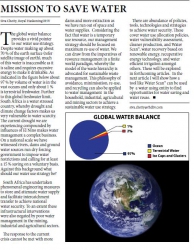Siva Chetty, Royal HaskoningDHV - Mission to save water2016-10-18 The global water balance provides a vivid pointer to our water use strategy. Despite water making up about 70 % of the earth surface (refer satellite image of earth), much of this water is inaccessible as it is saline and requires excessive energy to make it drinkable. As indicated in the figure below about 97 % by volume of water is in the vast oceans and only about 1 % is terrestrial freshwater. Further to this global freshwater limit, South Africa is a water stressed country, whereby drought and climate change factors makes us very vulnerable to water scarcity. The current drought we are experiencing compounded by influences of El Nino makes water management a complex business. On a national scale we have witnessed rivers, dams and ground water sources run dry forcing government to impose water restrictions and calling for at least a 15 % saving on a voluntary basis. Against this background what should our water use strategy be?
South Africa has undertaken phenomenal engineering measures to store and attenuate water supply and facilitate intercatchment transfer to achieve national water security. To an extent these infrastructural interventions were also negated by poor water management in the mining, industrial and agricultural sectors. The response to the current crisis cannot be met with more dams and more extraction as we have run out of space and water supplies. Considering the fact that water is a temporary use resource, our management strategy should be focused on maximum re-use of water. We can draw from the imperatives of resource management in a finite world paradigm, whereby the model of the waste hierarchy is advocated for sustainable waste management. This philosophy of avoidance, minimisation, re-use, and recycling can also be applied to water management in the household, industrial, agricultural and mining sectors to achieve a sustainable water use strategy. There are abundance of policies, tools, technologies and strategies to achieve water security. These cover water use allocation policies, water vulnerability assessment, cleaner production, and Water Scanâ„¢, water recovery based on renewable energy, recuperative energy technology, and water efficient irrigation amongst others. These will be explored in forthcoming articles. In the next article I will show how a tool like Water Scanâ„¢ can be used by a water using entity to find opportunities for water saving and water reuse. siva.chetty@rhdhv.com |
Siva Chetty, Royal HaskoningDHV - Mission to save water
Copyright © 2024 KwaZulu-Natal Top Business
